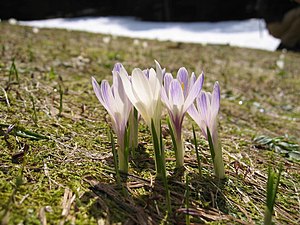Monocots
| Monocots | ||||||||||||
|---|---|---|---|---|---|---|---|---|---|---|---|---|

Spring Crocus ( Crocus vernus subsp. Albiflorus ) |
||||||||||||
| Systematics | ||||||||||||
|
The monocotyledons or monocotyledons are one of the large groups of flowering plants . They form a natural kinship group.
features
Essentially, it is mostly herbaceous plants that are perennial ; tree-shaped life forms such as palms are also part of it. In the seeds is in the embryo only one typically cotyledon applied, from which the name is derived, the off, in Greek , monos for "one" and cotyledon composed for "cotyledon." The main characteristics of this large group of flowering plants are the following: The radicle wither very quickly. Instead, similar lateral sprout roots are formed. Usually a main root is missing; one therefore speaks of a homorhic root system. (Root systems with main roots are called allorhiz and are mostly found in the other Bedecktsamern .) Vascular bundles are present in the entire cross section of the stem (stem axis) and do not culminate in concentric parallel arrangements , which is called ataktostele . Usually the stems do not branch. Monocots have closed vascular bundles, i. H. Phloem and xylem are not separated by a cambium , so secondary growth in thickness according to the mechanisms known from dicotyledons or gymnosperms is not possible.
The usually parallel- veined leaves usually have no petiole (exceptions, for example, with the Zingiberaceae , or the lily of the valley plants ). Leaf veins are very seldom pinnate, reticulate or palm-like (e.g. in the one-berry or taro ( Colocasia )). As a rule, there is no breakdown of the leaf blade, so more rarely the formation of compound leaves (such as in palm trees).
If the pericarp is typically not divided into a calyx (kalyx) and a crown (corolla), it is called a perigone . In some "higher" taxa, however, the bracts of the two tepal circles are shaped differently; so z. B. in the irises . The flower is usually threefold: two three similar looking bracts ( tepals ) (or three sepals (sepals) and petals (petals)), two three stamens and three carpels .
Occurrence
Monocot plants are found in almost every habitat on earth. Both aquatic forms (representatives of the frog-spoon family , duckweed family, etc.) and terrestrial forms are developed. The most species-rich group, that of orchids , is particularly common in the rainforests of the tropics and subtropics . The group with the greatest number of individuals is by far that of the sweet grasses , which are also represented in almost all climatic zones. Due to their economic benefit, the sweet grasses are probably the most important group of plants for humans, as all types of grain belong to them.
Systematics
The monocotyledons are a long-recognized family group. The Angiosperm Phylogeny Group following form a taxon . The previous name Monocotyledonae is no longer used in the Angiosperm Phylogeny Group system. Her sister group is the group of Ceratophyllales and Eudicotyledons .
The following orders are counted among them:
- Order Acorales (calamus)
- Order Alismatales (frog-spoon-like)
- Order Petrosaviales
- Order Dioscoreales (yam-like)
- Order Pandanales (screw tree-like)
- Order Liliales (lily-like)
- Order Asparagales (asparagus-like)
- without rank commelinids
- Order Arecales (palm-like)
- Order Commelinales (Commelinaartig)
- Order Zingiberales (gingery)
- Order Poales (sweet grasses)
For a breakdown down to the family level, see the systematics of the bedecktsamer .
The relationship between the orders can be shown in the following cladogram :
|
|
|
||||||||||||||||||||||||||||||||||||||||||
|
|
literature
- Joachim W. Kadereit , Christian Körner , Benedikt Kost , Uwe Sonnewald : Strasburger - Textbook of Plant Sciences. 37th, completely revised and updated edition of the textbook of botany . Springer Spectrum , Berlin / Heidelberg 2014, ISBN 978-3-642-54434-7 , section monocotyledons , pp. 657 ff. ( Limited preview in Google book search).
- Gertrud Dahlgren (Ed.): Systematic Botany . Springer-Verlag , Berlin / Heidelberg 1987, ISBN 978-3-642-71611-9 , section Monocotyledoneae (Liliatae) , p. 176–182 ( limited preview in Google book search - Swedish: Systematisk Botanik . Translated by Meinrad Küttel).
- Thomas Stützel: Botanical determination exercises . 3rd, completely updated edition. Verlag Eugen Ulmer , Stuttgart (Hohenheim) 2015, ISBN 978-3-8252-8549-4 , section 6.1 Monocotyledoneae , p. 63–76 ( limited preview in Google Book search).
Individual evidence
- ↑ a b c The Angiosperm Phylogeny Group : An update of the Angiosperm Phylogeny Group classification for the orders and families of flowering plants: APG IV . In: Botanical Journal of the Linnean Society. Volume 181, No. 1, 2016, pp. 1-20, doi : 10.1111 / boj.12385 .
Web links
- William J. Hahn: Monocotyledons in the Tree of Life web project (English)
- Peter von Sengbusch: Liliopsida - (Monocotyledons) in botany online . University of Hamburg (no longer processed after 2004)